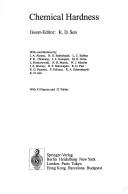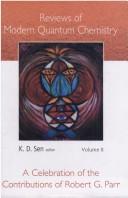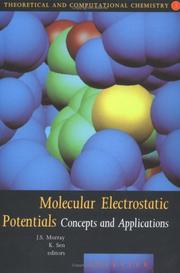| Listing 1 - 10 of 11 | << page >> |
Sort by
|
Book
ISBN: 3319099825 3319099817 Year: 2014 Publisher: Cham : Springer International Publishing : Imprint: Springer,
Abstract | Keywords | Export | Availability | Bookmark
 Loading...
Loading...Choose an application
- Reference Manager
- EndNote
- RefWorks (Direct export to RefWorks)
The present volume is a collection of review articles highlighting the fundamental advances made in the area of spatially confined simple atoms and molecules with focus on their electronic structure. The contributed chapters are conjoined together to provide a standard reference book in this rapidly growing area of interdisciplinary research spanning chemistry, physics, computational quantum chemistry and material science.
Electronic structure. --- Nuclear structure. --- Structure, Nuclear --- Nuclear physics --- Structure, Electronic --- Atomic structure --- Energy-band theory of solids --- Chemistry. --- Quantum theory. --- Engineering. --- Theoretical and Computational Chemistry. --- Quantum Physics. --- Nanotechnology and Microengineering. --- Construction --- Industrial arts --- Technology --- Quantum dynamics --- Quantum mechanics --- Quantum physics --- Physics --- Mechanics --- Thermodynamics --- Physical sciences --- Chemistry, Physical and theoretical. --- Quantum physics. --- Nanotechnology. --- Molecular technology --- Nanoscale technology --- High technology --- Chemistry, Theoretical --- Physical chemistry --- Theoretical chemistry --- Chemistry
Book
ISBN: 9400799438 9048138892 9786613470232 9048138906 1283470233 Year: 2011 Publisher: Dordrecht : Springer Netherlands : Imprint: Springer,
Abstract | Keywords | Export | Availability | Bookmark
 Loading...
Loading...Choose an application
- Reference Manager
- EndNote
- RefWorks (Direct export to RefWorks)
“I think the next century will be the century of complexity” Prof. Stephen W. Hawking (DAMPT, University of Cambridge, UK), San Jose Mercury News, Morning Final Edition, January 23 (2000) Several different measures defining complexity have been recently proposed within the scientific disciplines of physics, biology, mathematics and computer science. Such measures of complexity are generally context dependent. In chemical physics, a set of statistical complexity measures have been introduced using the information theoretical tools centering around the electron probability density of an N-electron system and its additional characteristics. The current monograph presents a detailed description of such measures of complexity. Starting with the information theoretical foundations, this monograph discusses at length their applications in the electronic structure of atoms and molecules including reactivity. The subject matter of the title is covered by the leading research scientists in the field who present an up-to-date account of their contributions, including future projections. Statistical Complexity: Applications in Electronic Structure is intended for practicing physical, theoretical and computational chemists, material scientists, bio physicists and mathematical physicists.
Density functionals --- Chemistry --- Physical Sciences & Mathematics --- Physical & Theoretical Chemistry --- Density functionals. --- Density functional methods --- Density functional theory --- Functional methods, Density --- Functionals, Density --- Chemistry. --- Physical chemistry. --- Chemistry, Physical and theoretical. --- Physical Chemistry. --- Theoretical and Computational Chemistry. --- Functional analysis --- Chemistry, Physical organic. --- Physical sciences --- Chemistry, Physical organic --- Chemistry, Organic --- Chemistry, Physical and theoretical --- Chemistry, Theoretical --- Physical chemistry --- Theoretical chemistry
Digital
ISBN: 9789048138906 Year: 2011 Publisher: Dordrecht Springer Netherlands
Abstract | Keywords | Export | Availability | Bookmark
 Loading...
Loading...Choose an application
- Reference Manager
- EndNote
- RefWorks (Direct export to RefWorks)
Physicochemistry --- Chemistry --- Computer. Automation --- chemie --- informatica --- fysicochemie
Digital
ISBN: 9783319099828 Year: 2014 Publisher: Cham Springer International Publishing
Abstract | Keywords | Export | Availability | Bookmark
 Loading...
Loading...Choose an application
- Reference Manager
- EndNote
- RefWorks (Direct export to RefWorks)
The present volume is a collection of review articles highlighting the fundamental advances made in the area of spatially confined simple atoms and molecules with focus on their electronic structure. The contributed chapters are conjoined together to provide a standard reference book in this rapidly growing area of interdisciplinary research spanning chemistry, physics, computational quantum chemistry and material science.
Quantum mechanics. Quantumfield theory --- Chemical structure --- Chemistry --- Applied physical engineering --- Biotechnology --- Computer. Automation --- quantumfysica --- quantumtheorie --- nanotechniek --- chemie --- informatica --- biotechnologie --- ingenieurswetenschappen

ISBN: 3540560912 0387560912 3540474420 Year: 1993 Volume: vol 80 Publisher: Berlin New York London Springer-Verlag
Abstract | Keywords | Export | Availability | Bookmark
 Loading...
Loading...Choose an application
- Reference Manager
- EndNote
- RefWorks (Direct export to RefWorks)
Acid-base chemistry --- Acid-base concepts --- Acid-base theories --- Acides et bases [Théorie des ] --- Base-acid chemistry --- Base-acid theories --- Chemistry [Acid-base] --- Zuren en basen [Theorie van ] --- 539.53 --- 541.45 --- #WSCH:AAS2 --- Base-acid concepts --- Chemistry, Acid-base --- Chemistry, Physical and theoretical --- Hardss. Softness. Hardness scales. Wear resistance --- Oxides. Acids. Bases --- Acid-base chemistry. --- 541.45 Oxides. Acids. Bases --- 539.53 Hardss. Softness. Hardness scales. Wear resistance --- Charge transfer complexes --- Electronegativity --- Lewis acids
Book
ISBN: 038717740X 354017740X 3540477861 Year: 1987 Volume: 66 Publisher: New York, NY ; Berlin : Springer-Verlag,
Abstract | Keywords | Export | Availability | Bookmark
 Loading...
Loading...Choose an application
- Reference Manager
- EndNote
- RefWorks (Direct export to RefWorks)
Electronegativity --- 541.57 --- Bonds --- Electronegativity. --- 541.57 Bonds
Book
ISBN: 3540586717 3540586725 0387586717 0387586725 3540490396 354049040X 9783540586715 9783540586722 Year: 1995 Volume: 173-174 Publisher: Berlin: Springer,
Abstract | Keywords | Export | Availability | Bookmark
 Loading...
Loading...Choose an application
- Reference Manager
- EndNote
- RefWorks (Direct export to RefWorks)
Molecular structure --- Similarity (Physics) --- Structure moléculaire --- Structure moléculaire --- Electron configuration. --- Molecular topology --- Quantum mechanics --- Similarity theory --- SIMILARITY THEORY --- TRANSITION STATE STRUCTURE,PERICYCLIC --- MACROMOLECULAR COMPOUNDS --- ELECTRIC POTENTIAL --- GRAPH THEORY --- ORGANIC COMPOUNDS --- PROPERTIES
Book
ISBN: 9789048138906 Year: 2011 Publisher: Dordrecht Springer Netherlands
Abstract | Keywords | Export | Availability | Bookmark
 Loading...
Loading...Choose an application
- Reference Manager
- EndNote
- RefWorks (Direct export to RefWorks)
I think the next century will be the century of complexity Prof. Stephen W. Hawking (DAMPT, University of Cambridge, UK), San Jose Mercury News, Morning Final Edition, January 23 (2000) Several different measures defining complexity have been recently proposed within the scientific disciplines of physics, biology, mathematics and computer science. Such measures of complexity are generally context dependent. In chemical physics, a set of statistical complexity measures have been introduced using the information theoretical tools centering around the electron probability density of an N-electron system and its additional characteristics. The current monograph presents a detailed description of such measures of complexity. Starting with the information theoretical foundations, this monograph discusses at length their applications in the electronic structure of atoms and molecules including reactivity. The subject matter of the title is covered by the leading research scientists in the field who present an up-to-date account of their contributions, including future projections. Statistical Complexity: Applications in Electronic Structure is intended for practicing physical, theoretical and computational chemists, material scientists, bio physicists and mathematical physicists.
Physicochemistry --- Chemistry --- Computer. Automation --- chemie --- informatica --- fysicochemie

ISBN: 9812775706 9789812775702 9789810248895 981024889X Year: 2002 Publisher: Singapore World Scientific
Abstract | Keywords | Export | Availability | Bookmark
 Loading...
Loading...Choose an application
- Reference Manager
- EndNote
- RefWorks (Direct export to RefWorks)
This important book collects together state-of-the-art reviews of diverse topics covering almost all the major areas of modern quantum chemistry. The current focus in the discipline of chemistry - synthesis, structure, reactivity and dynamics - is mainly on control. A variety of essential computational tools at the disposal of chemists have emerged from recent studies in quantum chemistry. The acceptance and application of these tools in the interfacial disciplines of the life and physical sciences continue to grow. The new era of modern quantum chemistry throws up promising potentiali
Quantum chemistry. --- Chemistry, Physical and theoretical. --- Chemistry, Theoretical --- Physical chemistry --- Theoretical chemistry --- Chemistry --- Chemistry, Quantum --- Chemistry, Physical and theoretical --- Quantum theory --- Excited state chemistry --- Quantum chemistry --- fysicochemie

ISBN: 9780444823533 0444823530 9780080536859 0080536859 9786611034191 1281034193 Year: 1996 Publisher: Amsterdam ; New York : Elsevier,
Abstract | Keywords | Export | Availability | Bookmark
 Loading...
Loading...Choose an application
- Reference Manager
- EndNote
- RefWorks (Direct export to RefWorks)
Over the past 25 years, the molecular electrostatic potential has become firmly established as an effective guide to molecular interactions. With the recent advances in computational technology, it is currently being applied to a variety of important chemical and biological systems. Its range of applicability has expanded from primarily a focus on sites for electrophilic and nucleophilic attack to now include solvent effects, studies of zeolite, molecular cluster and crystal behavior, and the correlation and prediction of a wide range of macroscopic properties. Moreover, the increasing promine
Quantum chemistry --- Quantum chemistry. --- Electromotive force. --- Chemical reaction, Conditions and laws of. --- Conditions and laws of chemical reaction --- Reaction, Conditions and laws of (Chemistry) --- Chemistry, Physical and theoretical --- Physical laws --- Electric potential --- EMF (Electromotive force) --- Force, Electromotive --- Potential, Electric --- Voltage --- Force and energy --- Chemistry, Quantum --- Quantum theory --- Excited state chemistry
| Listing 1 - 10 of 11 | << page >> |
Sort by
|

 Search
Search Feedback
Feedback About UniCat
About UniCat  Help
Help News
News